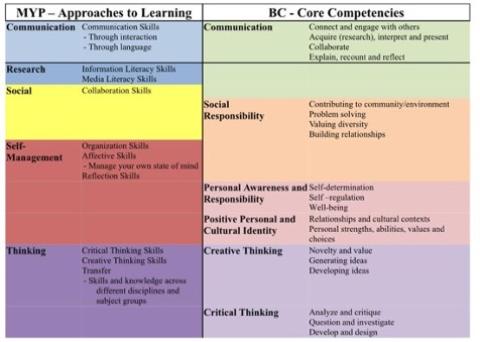Approaches to Learning
The Approaches to Learning (ATL) skills are “learning how to learn” skills that promote the Hugh Boyd mission to make our students lifelong learners. The BC New Curriculum’s Core Competencies align closely with the Approaches to Learning skills.
Feedback on student progress in Approaches to Learning (ATL) skills will be ongoing in the classroom, shared with students through formative and summative assessments and to parents and students through report card comments. Students will self-report their progression through the ATLs just as they did with Core Competencies in elementary school.
|
ATL Skill Category |
MYP ATL Clusters
|
|
Communication |
|
|
Social |
|
|
Self-Management |
|
|
|
|
|
|
Research |
|
|
|
|
Thinking |
|
|
|
|
Each department has chosen the ATLs that are most commonly utilized in their course areas. These are the ATLs most likely to be commented on and addressed in the comments of report cards. All subject areas can still develop skills outside of their subject specific focus, depending on what makes the most sense for the unit of study.
|
Subject |
Self Management |
Social |
Communication |
Research |
Thinking |
|
Art |
x |
x |
x |
|
|
|
Design |
x |
x |
|
|
|
|
Individuals and Societies |
x |
|
|
x |
x |
|
Language Acquisition |
x |
x |
x |
|
|
|
Language and Literature |
x |
x |
x |
|
x |
|
Math |
x |
|
x |
|
x |
|
Physical & Health Education |
x |
x |
|
|
|
|
Science |
x |
|
|
x |
|
N = Novice/beginning
- students are introduced to the skill, and can watch others performing it (observation)
L = Learner/developing
- students copy others who use the skill and use the skill with scaffolding and guidance (emulation)
P = Practitioner/using
- students employ the skill confidently and effectively (demonstration)
E = Expert/sharing
- students can show others how to use the skill, and accurately assess how effectively the skill is used (self-regulation)
